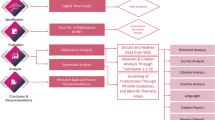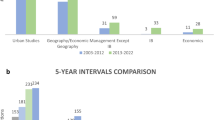Abstract
The industrial district may be seen as a species hosting not only many different cases, but also, more generally, some ideal–typical forms that characterize different historical contexts. The form that, according to previous contributions, seems to emerge in contemporary contexts of advanced economies under globalisation, technological and societal challenges, is the so-called Mark 3 ID. This paper expands precisely on differential features, contexts, and factors of strength and weakness of ID Mark 3. The thought of Giacomo Becattini, in particular his conception of the Marshallian industrial district, is assumed as a central reference point. The Mark 3 ID is discussed in this paper under the frame of such conception of industrial organization and development, centred on place-specific collective capital and specialized small-to-medium sized firms.
Similar content being viewed by others
Notes
C.H. Sabel, “The new organization of production, productive development policies and job creation or Thinking about industrial policy as industry becomes less central to development”, paper presented at the Conference on Relations Between Productive Development Policies, Jobs, Wages And Human Resources Brainstorming Session, Lima, January 22, 2016.
References
Amison, P., & Bailey, D. (2014). Phoenix industries and open innovation? The Midlands advanced automotive manufacturing and engineering industry. Cambridge Journal of Regions, Economy and Society, 7(3), 397–411.
Andreoni, A., & Chang, H. J. (2016). Industrial policy and the future of manufacturing. Economia e Politica Industriale, 43(4), 491–502 (Journal of Industrial and Business Economics).
Andreoni, M., & Gregory, M. (2013). Why and how does manufacturing still matter: Old rationales, new realities. Revue d’Économie Industrielle, 144(4), 21–57.
Baldwin, R. (2013). Global supply chains: Why they emerged, why they matter, and where they are going. In D. K. Elms & P. Low (Eds.), Global Value Chains in a Changing World (pp. 13–59). Geneva: WTO Publications.
Barca, F., McCann, P., & Rodríguez-Pose, A. (2012). The case for regional development intervention: Place-based versus place-neutral approaches. Journal of Regional Science, 52(1), 134–152.
Bathelt, H., Malmberg, A., & Maskell, P. (2004). Clusters and knowledge: Local buzz, global pipelines and the process of knowledge creation. Progress in Human Geography, 28(1), 31–56.
Becattini, G. (2004). Industrial Districts: A New Approach to Industrial Change. Cheltenham: Edward Elgar.
Becattini, G. (2015). Beyond geo-sectoriality: The productive chorality of places. Investigaciones Regionales, 32, 31–41.
Becattini, G., Bellandi, M., & De Propris, L. (2011). Industrial districts: The contemporary debate. Economia e Politica Industriale, 38(3), 53–75.
Bellandi, M. (1996). On entrepreneurship, region and the constitution of scale and scope economies. European Planning Studies, 4(4), 421–438.
Bellandi, M., & Caloffi, A. (2008). District internationalisation and trans-local development. Entrepreneurship and Regional Development, 20(6), 517–532.
Bellandi, M., & De Propris, L. (2015). Three generations of industrial districts. Investigaciones Regionales, 32, 75–87.
Bellandi, M., & Santini, E. (2017). Resilience and the role of arts and culture-based activities in mature industrial districts. European Planning Studies, 25(1), 88–106.
Belussi, F., & De Propris, L. (2013). They are industrial districts, but not as we know them! In F. Giarratani, G. J. D. Hewings, & P. McCann (Eds.), Handbook of industry studies and economic geography. Cheltenham: Edward Elgar.
Belussi, F., & Hervas Oliver, J. L. (Eds.). (2017). Unfolding cluster evolution. London: Routledge.
Bettiol, M., & Micelli, S. (2013). The hidden side of design: The relevance of artisanship. Design/Issues, 30(1), 7–18.
Bianchi, P., & Labory, S. (2011). Industrial policy after the crisis: Seizing the future. Cheltenham: Edward Elgar Publishing.
Binz, C., & Truffer, B. (2017). Global innovation systems—a conceptual framework for innovation dynamics in transnational contexts. Research Policy, 46(7), 1284–1298.
Boix, R., Sforzi, F., & Hernández, F. (2015). Rethinking industrial districts in the XXI Century. Investigaciones Regionales, 32(2015), 5–8 (Journal of Regional Research).
Brusco, S. (1992). Small firms and the provision of real services. In F. Pyke & W. Sengenberger (Eds.), Industrial districts and local economic regeneration (pp. 177–196). Geneva: International Institute for Labor Studies.
Cappellin, R. (2012). Growth in post-industrial cities: An endogenous model. In R. Cappellin, F. Ferlaino, & P. Rizzi (Eds.), La città nell’economia della conoscenza (pp. 29–50). Milano: Franco Angeli.
Cohen, W. M., & Levinthal, D. A. (1990). Absorptive capacity: A new perspective on learning and innovation. Administrative Science Quarterly, 35(1), 128–152.
Coltorti, F. (2013). Italian industry, decline or transformation? A framework. European Planning Studies, 21(12), 2037–2077.
Cooke, P. (2009). Technology clusters, industrial districts and regional innovation systems. In G. Becattini, M. Bellandi, & L. De Propris (Eds.), A handbook of industrial districts (pp. 295–306). Cheltenham: Edward Elgar.
Cooke, P., & Lazzeretti, L. (Eds.). (2008). Creative cities, cultural clusters and local economic development. Cheltenham: Edward Elgar.
Corò, G., & Grandinetti, R. (1999). Evolutionary patterns of Italian industrial districts. Human Systems Management, 18(2), 117–129.
Corradini, C., & De Propris, L. (2016). Beyond local search: Bridging platforms and inter-sectoral technological integration. Research Policy, 46(1), 196–206.
Cossentino, R., Pyke, F., & Sengenberger, W. (Eds.). (1996). Local and regional response to global pressure: The case of Italy and its industrial districts. Geneva: International Institute for Labour Studies.
Crespi, G., Fernández-Arias, E., & Stein, E. H. (Eds.). (2014). Rethinking productive development: Sound policies and institutions for economic transformation. Inter-American Development Bank (IDB) series. New York: Palgrave Macmillan.
Crevoisier, O., & Jeannerat, H. (2009). Territorial knowledge dynamics: From the proximity paradigm to multi-location milieus. European Planning Studies, 17(8), 1223–1241.
Dei Ottati, G. (2003). Exit, voice and the evolution of industrial districts: The case of the post-World War II economic development of Prato. Cambridge Journal of Economics, 27(4), 501–522.
Derudder, B., De Vos, A., & Witlox, F. (2011). Global city/world city. In B. Derudder, M. Hoyler, P. J. Taylor, & F. Witlox (Eds.), International handbook of globalization and world cities. Cheltenham: Elgar.
EU Commission (2014). For a European Industrial Renaissance, Communication from the Commission to the European Parliament, The Council, The European Economic and Social Committee and the Committee of the Regions. COM/2014/014, Brussels.
Florida, R. (2002). The rise of the creative class: And how it’s transforming work, leisure, community and everyday life. New York: Perseus Book Group.
Giarratani, F., Hewings, G. J. D., & McCann, P. (Eds.). (2013). Handbook of industry studies and economic geography. Cheltenham: Edward Elgar.
Guercini, S., Dei Ottati, G., Baldassar, L., & Johanson, G. (Eds.). (2017). Native and immigrant entrepreneurship: Lessons for local liabilities in globalization from the Prato Case Study. Berlin: Springer.
Iammarino, S., & McCann, P. (2006). The structure and evolution of industrial clusters: Transactions, technology and knowledge spillovers. Research Policy, 35(7), 1018–1036.
Jensen, M. B., Johnson, B., Lorenz, E., & Lundvall, B. Å. (2007). Forms of knowledge and modes of innovation. Research Policy, 36(5), 680–693.
Leydesdorff, L., & Deakin, M. (2011). The triple-helix model of smart cities: A neo-evolutionary perspective. Journal of Urban Technology, 18(2), 53–63.
Marshall, A. (1919). Industry and Trade. London: Macmillan. (rpt. 2011 New York, NY: Cosimo).
Marshall, A. (1920). Principles of economics. London: Macmillan. (8th ed.; first ed. 1890, re-edited as vol. 1 of Guillebaud, C. W. ed. 1961, 9th Variorum ed. London: Macmillan).
McCann, P., & Ortega-Argilés, R. (2013). Modern regional innovation policy. Cambridge Journal of Regions, Economy and Society, 6, 187–216.
Popp, A., & Wilson, J. (2009). The emergence and development of industrial districts in industrialising England, 1750–1914. In G. Becattini, M. Bellandi, & L. De Propris (Eds.), A Handbook of industrial districts (pp. 43–57). Edward Elgar: Cheltenham.
Porter, M. E., & Heppelmann, J. E. (2014). How smart, connected products are transforming competition. Harvard Business Review, 92(11), 64–88.
Porter, M. E., & Ketels, C. (2009). Clusters and industrial districts: Common roots, different perspectives. In G. Becattini, M. Bellandi, & L. De Propris (Eds.), A handbook of industrial Districts (pp. 172–183). Edward Elgar: Cheltenham.
Rabellotti, R., Carabelli, A., & Hirsch, G. (2009). Italian industrial districts on the move: Where are they going? European Planning Studies, 17(1), 19–41.
Robinson, E. A. G. (1958). The Structure of Competitive Industry. Cambridge: Cambridge University Press. (first ed. 1931).
Rullani, E. (2009). Global challenges: Introduction to section 10. In G. Becattini, M. Bellandi, & L. De Propris (Eds.), A handbook of industrial Districts (pp. 643–647). Edward Elgar: Cheltenham.
Sabel, C. H. (2002). What to make of the changes in Industrial Districts? Three questions. Lecture for the 2012 Prize Award, Global Award for Entrepreneurship Research, 1–2 (http://www.e-award.org/web/2002_Becattini_Sabel.aspx). Accessed 14 July 2017.
Sabel, C. H., & Zeitlin, J. (2004). Neither modularity nor relational contracting: Inter-firm collaboration in the new economy. Economy and Society, 5(3), 388–403.
Santagata, W. (2002). Cultural districts, property rights and sustainable economic growth. International Journal of Urban and Regional Research, 26, 9–23.
Segesseman, A., & Crevoisier, O. (2016). Beyond economic base theory: The role of the residential economy in attracting income to Swiss regions. Regional Studies, 50(8), 1388–1403.
Sengenberger, W. (2009). The scope of industrial districts in the Third World. In G. Becattini, M. Bellandi, & L. De Propris (Eds.), A Handbook of Industrial Districts (pp. 630–640). Cheltenham: Edward Elgar.
Sforzi, F. (2015). Rethinking the industrial district: 35 years later. Journal of Regional Research., 32, 11–29.
Tödtling, F., & Trippl, M. (2013). Transformation of regional innovation systems. In P. Cooke (Ed.), Re-framing regional development: evolution, innovation, and transition (pp. 297–317). New York: Routledge.
Tomlinson, P. R., & Branston, J. R. (2014). Turning the tide: Prospects for an industrial renaissance in the North Staffordshire ceramics industrial district. Cambridge Journal of Regions, Economy and Society, 7(3), 489–507.
Trullén, J., Boix, R., & Galletto, V. (2013). An insight on the unit of analysis in urban research. In P. K. Kresl & J. Sobrino (Eds.), Handbook of research methods and applications in urban economies (pp. 235–267). Northampton: Edward Elgar.
Visser, E. J., & Boschma, R. (2004). Learning in districts: Novelty and lock-in in a regional context. European Planning Studies, 12(6), 793–808.
Acknowledgements
This research was supported by the EU under H2020 Marie Skłodowska-Curie Actions project “MAKERS: Smart Manufacturing for EU Growth and Prosperity”, Grant Agreement No. 691192.
Author information
Authors and Affiliations
Corresponding author
Rights and permissions
About this article
Cite this article
Bellandi, M., De Propris, L. New forms of industrial districts. Econ Polit Ind 44, 411–427 (2017). https://doi.org/10.1007/s40812-017-0082-9
Received:
Revised:
Accepted:
Published:
Issue Date:
DOI: https://doi.org/10.1007/s40812-017-0082-9
Keywords
- Industrial districts and Giacomo Becattini
- Forms of Marshallian industrial districts
- Globalisation
- Technological and societal challenges




